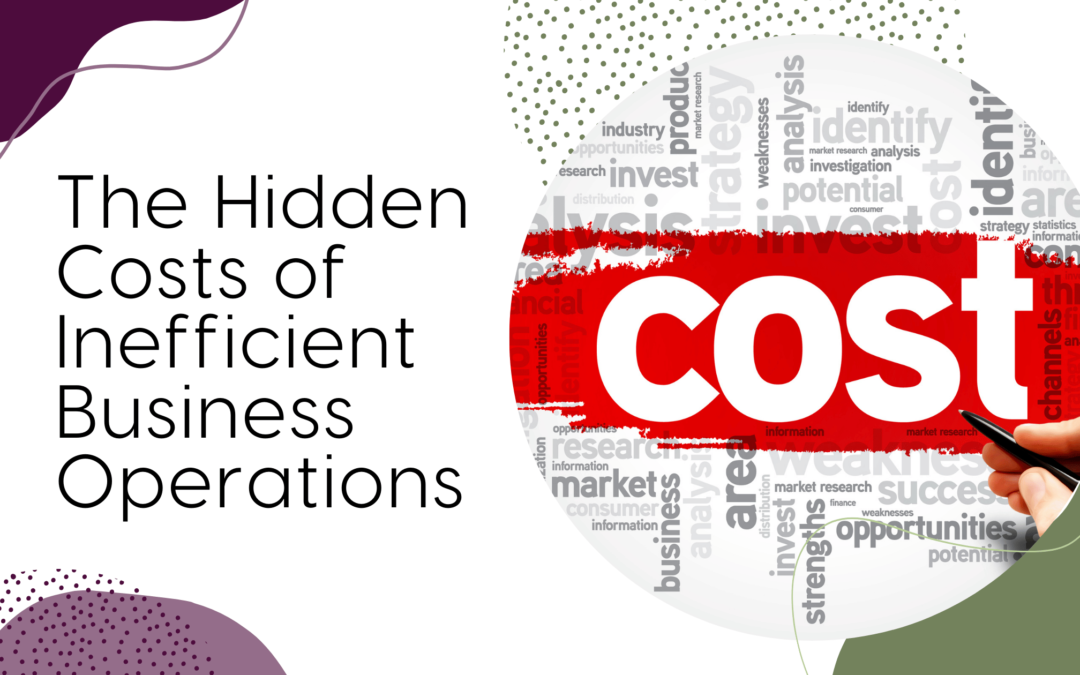The hidden costs of inefficient business operations can have far-reaching and often underestimated costs.
In the competitive and always-changing business world, efficiency is not just a luxury; it’s a necessity, especially for small business owners and entrepreneurs.
While large corporations may weather inefficiencies due to their scale, small businesses often operate on tighter margins where inefficiencies can be detrimental.
This article explores the often-underestimated costs of inefficiency and underscores the importance of streamlined operations for small business success.
1. Opportunity Costs

What Are Opportunity Costs?
Opportunity costs represent the potential benefits that businesses miss out on when they choose one alternative over another.
For small business owners and entrepreneurs, this often means the valuable opportunities that are foregone due to inefficient processes.
And when you’re working hard to grow and retain clients, most entrepreneurs and small business owners can’t afford to lose money and opportunities!
Why It Matters:
For small businesses, the ability to pivot quickly and seize new opportunities is crucial. Inefficient processes, whether due to outdated technology, cumbersome procedures, or poor communication, can severely limit this agility.
For example, a small retail store may miss out on expanding its product line or an entrepreneur might delay launching a new service due to slow decision-making processes. Or a client decides not to renew their services with you and is unhappy with how their customer journey was.
These missed opportunities can have a significant impact on growth potential and competitive edge.
2. Employee Morale and Productivity
What Is the Impact on Employee Morale and Productivity?
Operational inefficiencies don’t just affect the financials; they also impact employees.
In small businesses, where every team member’s contribution is vital, inefficiencies can lead to unnecessary workload, delays, and frustration.
Don’t have any team members yet? It’s ok, you will and you need to be prepared to support and lead them properly.

Why It Matters:
In a small business setting, employees often wear multiple hats, making their productivity even more critical. Inefficiencies can lead to burnout, disengagement, and ultimately, higher turnover rates.
High turnover is particularly costly for small businesses, which may not have the resources for constant recruitment and training.
A disengaged workforce can also stifle innovation and reduce the overall quality of work, affecting customer satisfaction and business reputation.
As an entrepreneur and small business owner, you can’t afford to add anything back to your plate once you’ve mastered delegation and productivity!
3. Financial Implications

What Are the Financial Costs?
The financial implications of inefficient business operations are multifaceted, especially for small businesses.
These include both direct and indirect costs.
Why It Matters
For small business owners and entrepreneurs, every dollar counts. Inefficient operations can lead to:
Increased Operational Costs: Small businesses might face higher costs due to wasted time and resources. For example, inefficient inventory management can lead to overstocking or stockouts, both of which are costly.
Wasted Resources: Inefficiencies often result in significant waste, whether it’s raw materials, energy, or labor. This not only increases costs but also affects sustainability efforts, which are increasingly important to consumers.
Lost Revenue Opportunities: Inefficiencies can prevent small businesses from capitalizing on revenue-generating opportunities. For instance, slow order processing can lead to lost sales, while inefficient marketing strategies might fail to attract new customers. And as mentioned above in the lost opportunities, unhappy clients or customers who decide not to continue to work with you or buy your products. This results in lost revenue and limits growth potential.
Stress and Work/Life Imbalance: Worrying out the bottom line and having extra work put on you as the business owner and your tem causes undue and preventable stress. This can lead to a work and personal life unbalance where you’re putting in more time to handle fixing the inefficiencies and any client problems it can present. And this means you might be missing out on opportunities. See my blog on Navigating Work-Life Balance as an Entrepreneur .
The hidden costs of inefficient business operations are extensive and can be particularly damaging for small business owners and entrepreneurs.
From opportunity costs and employee morale to financial implications, inefficiencies can hinder growth and success. By recognizing and addressing these inefficiencies, small businesses can unlock significant potential for growth, improve employee satisfaction, and enhance financial health. In today’s competitive environment, striving for operational excellence is not just beneficial—it’s essential for long-term success and sustainability.
Small business owners and entrepreneurs must prioritize efficiency to stay competitive and thrive. Whether it’s investing in technology, streamlining processes, or fostering a culture of continuous improvement, addressing inefficiencies is a critical step toward achieving business success.

